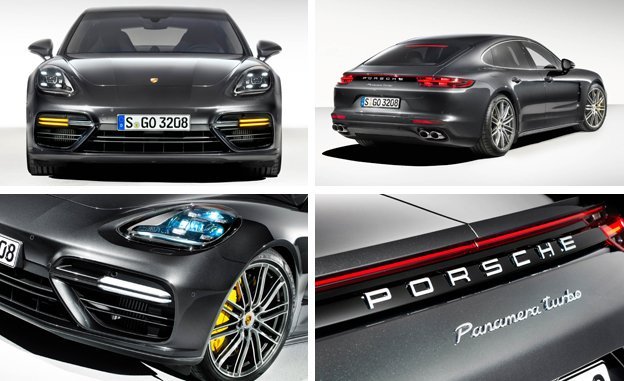When Porsche originally decided to move forward with the Panamera, a lot of options were on the menu, including a traditional three-box sedan. But there were enough of those in the market, and not so many hatchbacks. Since then, more hatchbacks have joined the luxury arena, including the Audi A7 and the Tesla Model S. But the Panamera stands alone: More spacious than the A7 and more luxurious than the Tesla, it’s a valid contender against the Audi A8, the BMW 7-series, and the Mercedes-Benz S-class, although its shape and dynamics pit it against top versions of the Germans’ sleeker offerings, such as the Audi RS7, BMW M6 Gran Coupe, and Mercedes-AMG CLS63 S.
Easy on the Eyes
The second generation of the Panamera, which Porsche launched at a lavish event in Berlin, takes everything a step forward: It’s slightly bigger, it’s more powerful, it’s said to perform better, and it’s fitted with a cutting-edge man-machine interface. What’s more, it looks better—a lot better. When we rode along on a prototype drive in South Africa earlier this year, we got a sense of the much-improved proportions of the new car. Its roofline has been lowered over the rear passengers, and the shape of the side-window opening resembles that of the 911.
Now the camouflage has been lifted entirely, and we really like what we see. The LED headlights, available in various levels of technical sophistication, look futuristic, and the taillights resemble the 911’s. They stretch all the way across the Panamera’s rear, and the effect is as stunning as it is ultramodern.
The Panamera is the first model built off the Volkswagen Group’s MSB architecture (Modularer Standard-Baukasten, or modular standard architecture—with “standard” here indicating a front-engine, rear- or four-wheel-drive layout). The powertrains are new. At launch, there will be a 2.9-liter twin-turbo V-6 in the Panamera 4S, rated at 440 horsepower, and a 4.0-liter twin-turbo V-8 in the Panamera Turbo, good for 550 horsepower. Europe also gets a 422-hp 4.0-liter V-8 turbo diesel; we don’t, but down the road, we will get an entry-level 3.0-liter turbo gasoline V-6 with around 350 horsepower, as well as a hybrid. A 3.0-liter V-6 TDI, which is the only carryover engine, will remain absent from the U.S. Expect a Turbo S again, this time with at least 600 horsepower, and a further entry-level model—designed for maximum efficiency but not hybridized—could come with rear-wheel drive. Initially, all Panameras will feature all-wheel drive and a ZF-sourced eight-speed dual-clutch automatic.
The new Panamera’s performance encroaches on supercar territory. The 4S, which shares its engine with the upcoming Audi RS4 and RS5, charges from zero to 62 mph in a claimed 4.4 seconds; the Turbo manages it in 3.8 seconds, and in both cases, the optional Sport Chrono package shaves off a further 0.2 second thanks to its launch-control function. Stated top speed is 180 mph for the 4S and 190 mph for the Turbo. But fuel consumption is said to be lower by over 10 percent in both models.
Porsche’s Four-Door Trio
Similarly exciting are the body variations: Porsche has officially confirmed that it will do a station-wagon version of the Panamera (previewed by the fetching Sport Turismo concept), and that it will be sold in the United States. Moreover, there again will be a stretched Panamera, likely to carry forward the Executive designation.
It’s not that the Panamera needs extra wheelbase. Despite the lower roofline above the rear passengers, headroom is virtually the same as before, which is to say generous. The trunk is bigger, too. Meanwhile, the interior ambience has been thoroughly upgraded, both up front and in the rear. The Panamera comes with an entirely rethought and redesigned user interface. While keeping the previous model’s aesthetics, characterized by angular horizontal lines and an array of buttons, the new model switches to a touchscreen interface in the center console both in the front and (optionally) in the rear. Above the console, Porsche has fitted a large TFT screen. The driver looks at a relatively slim instrument cluster with an analog central tachometer flanked by TFT screens. There is no optional head-up display, however, which seems a glaring omission.
When we rode in the new Panamera’s final prototypes, we were stunned by the incredible roadholding and the balance between performance and comfort. It’s an impressive car even with the standard suspension, but it truly shines when fitted with the optional three-chamber air springs, the active anti-roll system, and the rear-wheel-steering system (which requires a 48-volt electrical circuit in addition to the standard 12-volt architecture).
The new Panamera is expected to be priced similarly to its predecessor; figure an entry-level price of just over $100K for the 4S and around $150K for the Turbo.
Powered by WPeMatico






